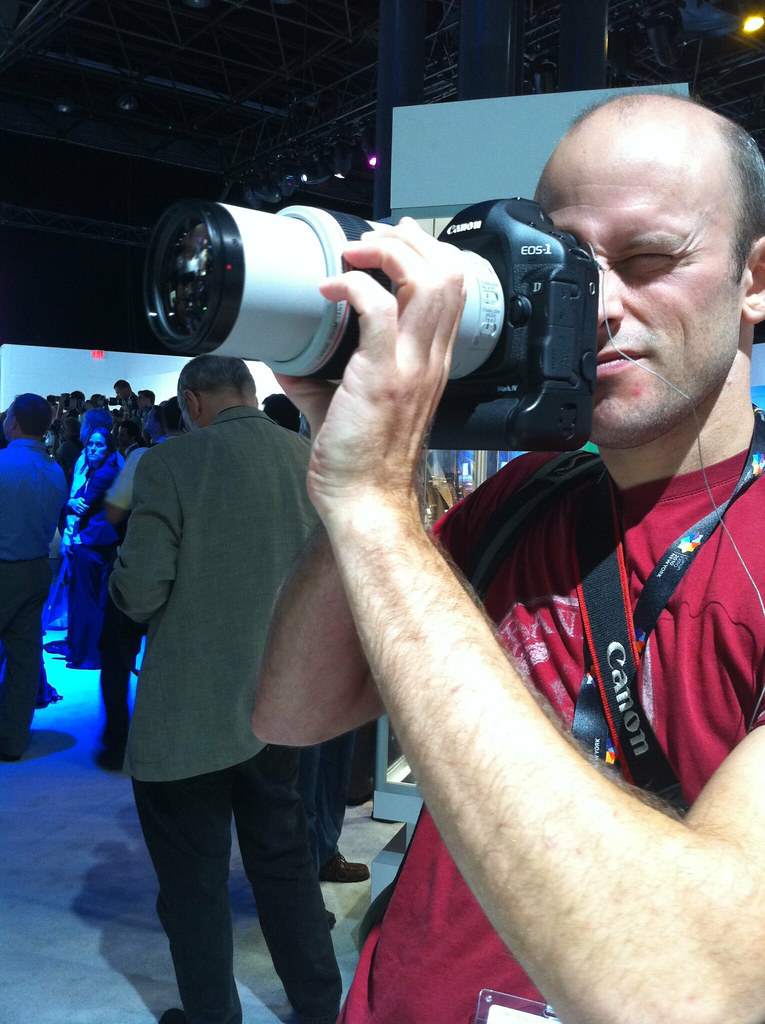1100$ Canon EOS 60D Digital SLR Camera
Canon EF 8-15mm f/4 L USM Fisheye Lens 1400 $
Canon EF 70-300mm f/4-5.6 IS L USM Lens 1500$
Canon EF 300mm f/2.8 L IS II USM Lens 7000$
Canon EF 400mm f/2.8 L IS II USM Lens 11000$
Canon Extender EF 1.4x III 500$
500 $ Canon Extender EF 2x III
از آدوراما
نمایش نتایج : از شماره 31 تا 40 , از مجموع 114
-
Monday 30 August 2010, 15:30 #31
 پاسخ : EF 70-300 f/4-5.6L IS USM
نادر مسلمی
پاسخ : EF 70-300 f/4-5.6L IS USM
نادر مسلمی
-
Monday 30 August 2010, 16:48 #32
 پاسخ : EF 70-300 f/4-5.6L IS USM
پاسخ : EF 70-300 f/4-5.6L IS USM




ايضاًً:
با جازه اساتيد محترم،
دوستان دلم نيامد درمورد موضوع مهم بوكه صحبتي نشود.
نمودارهاي فوق نمودار سمت راست مربوط به 300-70 اف 5.6-4 ال آي اس و سمت چپ 200-70 اف 4 آي اس است.
طبق تعريف مندرج در سايت رسمي كانن، منحنيهاي نازك مشكي و آبي نقطه چين هرچه به هم نزديكتر (و درحالت ايده آل اگر برهم كاملاً مماس) باشند نشان دهنده كيفيت بوكه بهتر لنز است.
خب آنطور كه نمودارهاي فوق نشان ميدهد لنز 300-70 از اين حيث اندكي بهتر از 200-70 است.
خوشحال ميشوم دوستان نظراتشان را دراين باره بفرمايند.
دوستان ضمناً براي مطالعه مطلبي مفيد درباره نمودارهاي MTF لنزها ونحوه تفسير آنها (كه بنده هم تفسيرهاي فوق را با استفاده از اين راهنما عرض كردم) به اين لينك رجوع كنيد.ویرایش توسط translator : Monday 30 August 2010 در ساعت 17:01 دلیل: اصلاح
Canon 5D II | Canon EF 16-35 f/2.8 LII USM| Canon EF 70-200 f/4 LIS USM l Canon 430 EX II
l Canon EF 100mm f/2.8 Macro LIS USM l
يوسف جمسي
-
Tuesday 31 August 2010, 13:22 #33كاربر بسیار فعال


- تاریخ عضویت
- April 2009
- محل سکونت
- تهران
- نوشته ها
- 1,889
- تشکر شده
- 20281
- تشکر کرده
- 10736
 پاسخ : EF 70-300 f/4-5.6L IS USM
پاسخ : EF 70-300 f/4-5.6L IS USM
-
Tuesday 31 August 2010, 14:38 #34
 پاسخ : EF 70-300 f/4-5.6L IS USM
پاسخ : EF 70-300 f/4-5.6L IS USM
امير جان درست ميفرماييد ولي چون بحث اين لنز از بقيه لنزها جدا شده و هنوز به بازار ارائه نشده تا قيمت فروشش باز بشه رقمهاي پيش فروش به نوعي درج شد تا نسبت ارزش به كيفيت بدست بياد.
من بيشتر فكر ميكردم اين لنز با قيمتي بيشتر ارائه بشه ولي از قيمت پيشنهادي كانن تعجب كردم.
به هر حال فرمايش شما كاملا درسته و ممنون.نادر مسلمی
-
Friday 3 September 2010, 21:39 #35
 پاسخ : EF 70-300 f/4-5.6L IS USM
پاسخ : EF 70-300 f/4-5.6L IS USM
Canon EXPO 2010
نویسنده وبلاگ از خوش ساخت بودن ، وزن مناسب و فوکوس سریع این لنز تعریف کرده است.

Canon showed off at its expo two new zoom lenses that are as different as night and day. On one side, the 70-300mm F4-5.6 L IS zoom lens offers a range of high-powered telephoto reach with a seemingly excellent image stabilization system. On the other side, the 8-15mm F4 L fisheye zoom lens offers a wide to really-super-ultra-wide angle, accomplishing some impressive optical gymnastics in the process. I spent some time with both lenses, and I was impressed (and at one point, amazed) by what I saw.
Canon 70-300mm F4-5.6 L IS
The 70-300mm lens got remarkably close to Canon’s demonstration subjects, a group of ice dancers in a mock-up of the Rockefeller Center ice rink. At full 300mm reach, I could capture sharp close-ups of the dancers’ faces as they spun on the faux ice.
Unfortunately, Canon didn’t let me use the lens with my own camera, or record the pictures on my own CF card; I had to use the EOS 60D they paired with the lens, and I couldn’t keep the pictures for analysis. However, from what I saw on the 60D’s screen, the lens managed to take incredibly clear, accurate pictures even at high speeds. The seeming sharpness is a testament to both the lens’s optical elements and its image stabilization system; my hands aren’t particularly steady, and a 300mm zoom would usually be a blur-fest under any conditions.
While the lens is certainly solid, it’s not particularly heavy and seemed very easy to carry on the 60D’s small frame. The focus and zoom rings are large and and grippable, and the three autofocus and stabilizer switches are similarly big, making thumbing the different settings and adjusting focus and zoom while staring into a viewfinder very easy. The autofocus seemed quite fast, rapidly locking on the faces of the ice dancers at full zoom.
طول لنز هم ثابت نیست

عکس در سایز اصلی :
منبع به همراه عکس های بیشترکد:http://thephoblographer.files.wordpress.com/2010/09/chris-gampat-canon-expo-2010-thephoblographer-zoom-lenses-9-of-9.jpg
کد:http://thephoblographer.com/2010/09/02/canonexpo-hands-on-canon-70-300mm-f4-5-6-l-is-and-8-15mm-f4-l-fisheye-zoom-lenses/
-
Friday 3 September 2010, 22:09 #36
 پاسخ : EF 70-300 f/4-5.6L IS USM
پاسخ : EF 70-300 f/4-5.6L IS USM
سلام
این لنز افزایش طول داشته و اینترنال زوم نیست
البته فکر نمی کنم پوئن منفی برای لنز حساب شود و ظاهرا
rotate ندارد یعنی دهانه لنز نمی چرخد
با این اوصاف یک مقدار نظرها عوض خواهد شد آیا؟«موفقيت» بدستآوردن چيزی است که دوست داری و «خوشبختی» دوست داشتن چيزی است که بدستآوردهای.
محمد حسین حاجی شاه کرم
-
Thursday 9 September 2010, 12:14 #37
 پاسخ : EF 70-300 f/4-5.6L IS USM
پاسخ : EF 70-300 f/4-5.6L IS USM
دوستان اینهم عکسی که نشون میده این لنز موقع زوم افزایش طول پیدامیکنه:
 Canon 5D II | Canon EF 16-35 f/2.8 LII USM| Canon EF 70-200 f/4 LIS USM l Canon 430 EX II
Canon 5D II | Canon EF 16-35 f/2.8 LII USM| Canon EF 70-200 f/4 LIS USM l Canon 430 EX II
l Canon EF 100mm f/2.8 Macro LIS USM l
يوسف جمسي
-
Monday 13 September 2010, 23:41 #38
 پاسخ : EF 70-300 f/4-5.6L IS USM
پاسخ : EF 70-300 f/4-5.6L IS USM
Hand On Preview
Canon EF 70-300mm f/4-5.6 IS L USM Lens
یک ریویو خلاصه از وب سایت The Digital Picture
ریویو اصلی و کامل بعدا ارائه می شود.
A full Canon EF 70-300mm f/4-5.6 IS L USM Lens review is planned.
I have had hands-on experience with a preproduction Canon EF 70-300mm f/4-5.6 IS L USM Lens and will share my preview thoughts with you
کد:http://www.the-digital-picture.com/Reviews/Canon-EF-70-300mm-f-4-5.6-IS-L-USM-Lens-Review.aspx
-
Tuesday 14 September 2010, 00:14 #39
 پاسخ : EF 70-300 f/4-5.6L IS USM
پاسخ : EF 70-300 f/4-5.6L IS USM
متن زير برگرفته از ريويوي پست قبلي است :
بالاخره چي شد ؟the Canon EF 70-300mm f/4-5.6 IS L USM Lens focuses very quickly and quietly without extending the lens or rotating the filter threads (important when using come filters including Circular Polarizer Filters)
طول لنز موقع زوم تغيير مي كنه يا نه ؟؟
-
Tuesday 14 September 2010, 00:22 #40
 پاسخ : EF 70-300 f/4-5.6L IS USM
پاسخ : EF 70-300 f/4-5.6L IS USM

 404تشکر
404تشکر LinkBack URL
LinkBack URL About LinkBacks
About LinkBacks
 پاسخ با نقل قول
پاسخ با نقل قول
